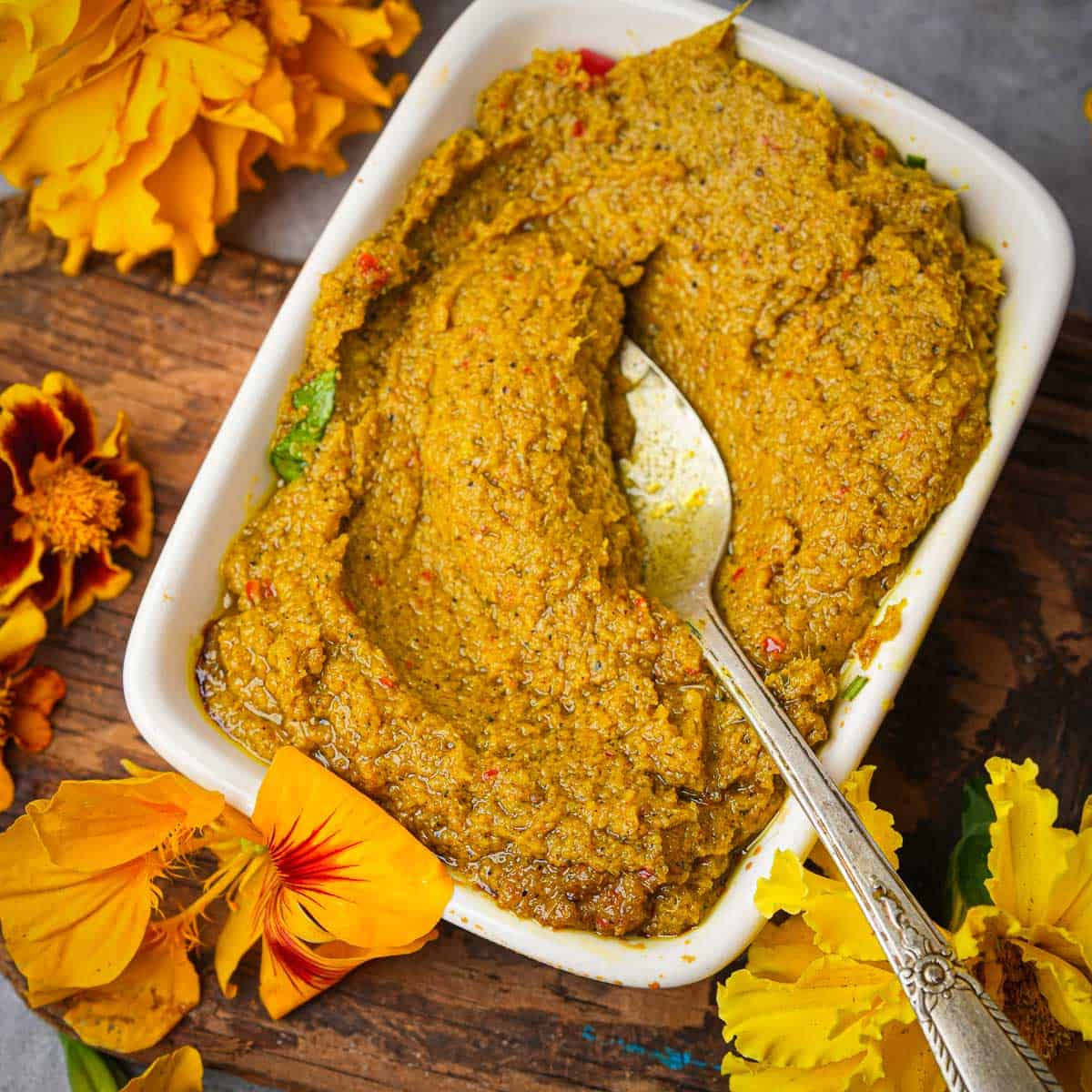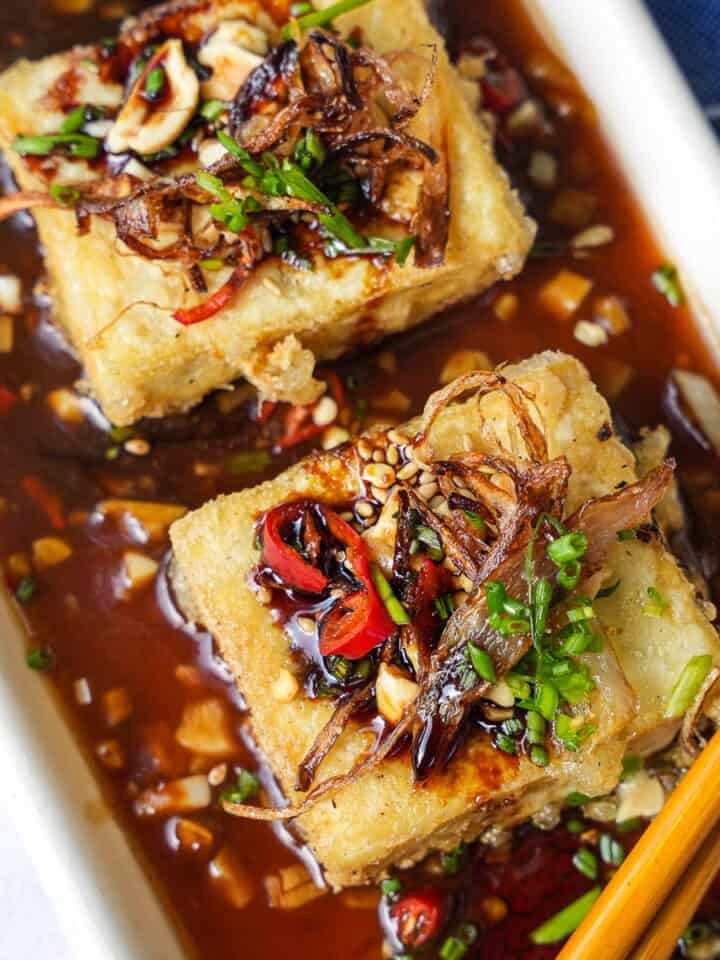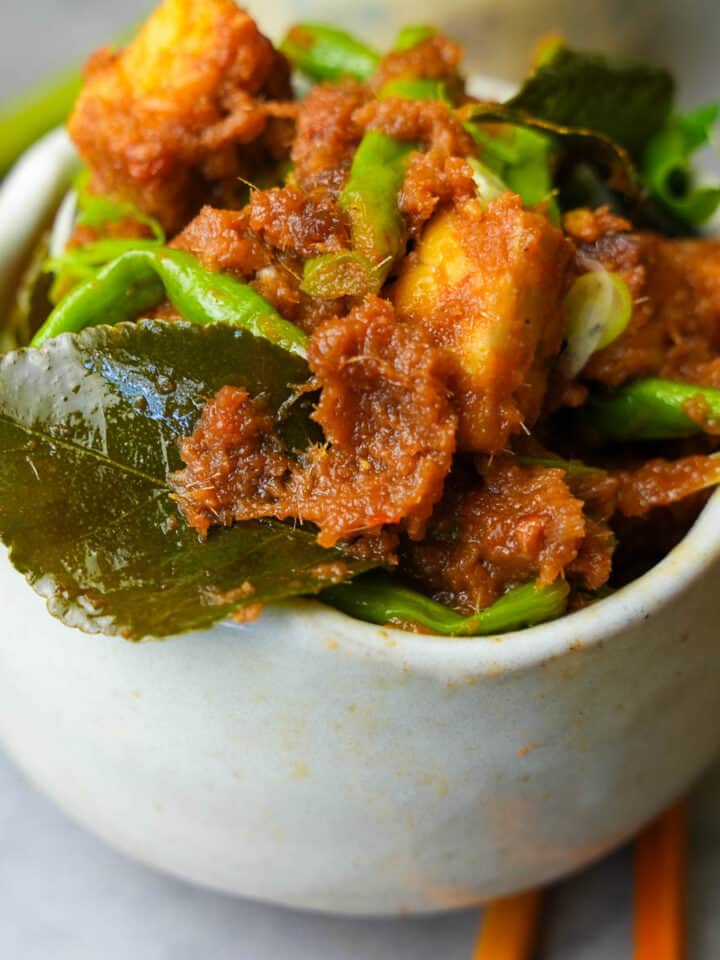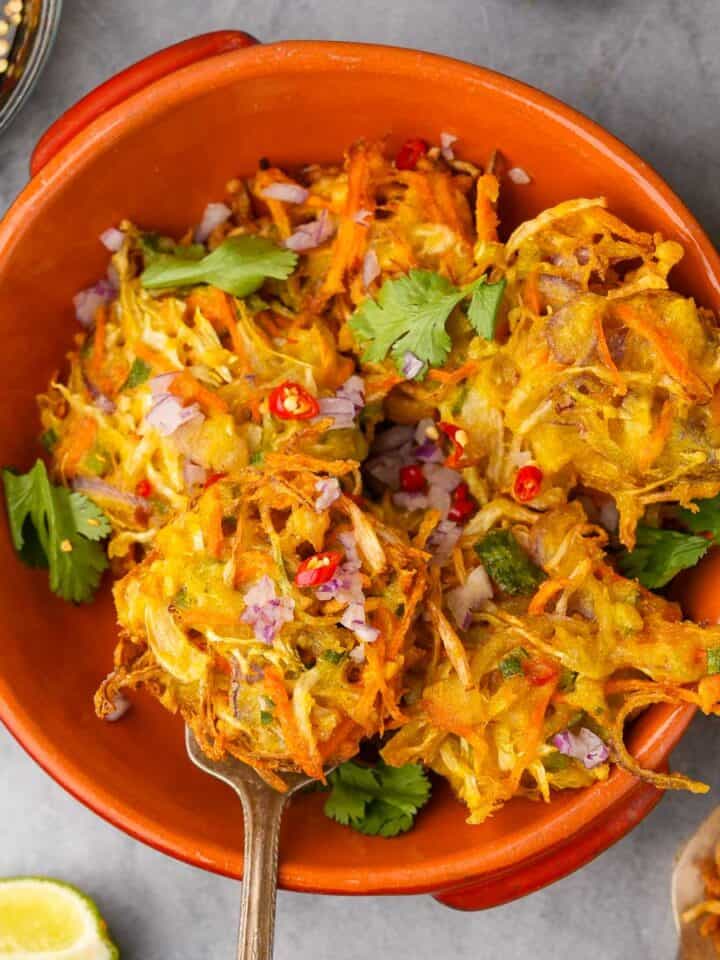*This post may contain affiliate links. Read more »
Listen up, this recipe for Bumbu Bali Paste, sometimes referred to as base genep will forever alter your Indonesian cooking and unlock some of the precious secrets of authentic Balinese cuisine. It’s like being able to infuse noodles, rice, and even brunch dishes with irresistible aromatic heat that you have on tap in your fridge or freezer!


Enter your email & I'll send it to your inbox. Plus, get great new recipes from me every week!
By submitting this form, you consent to receive emails from Cinnamon Snail.
A Balinese dish’s foundation is a potent spice mix known as Basa Gede or Bumbu Bali, which translates to “big spice base.” Like a sambal, this iconic paste is a blend of indigenous spices and aromatic herbs, designed to instantly infuse your cooking with a symphony of tastes and aromas.
You can add a little to Indonesian rice dishes like nasi minyak, and nasi uduk. Or add some to your favey stir-fried noodle dishes like bihun goreng, or mee goreng to intensify their flavors.
But why should you try this recipe? Well, first and foremost, it’s the secret to achieving the authentic flavors of Bali in your home kitchen. With a few simple steps, you’ can replicate the magic of the island’s culinary traditions, regardless of your experience level, whether you use a blender, food processor, or mortar and pestle. I provide tips for all three methods.
Get ready to arm yourself with a Balinese secret weapon in the kitchen. This is quick to make, so let’s dive in!
Jump to:
🥰Why you'll adore this bumbu bali recipe
🌱 Vegan AF and GF: Like all of my Indonesian recipes, this spice paste is 100% plant-based. And what’s more? It’s completely gluten-free. No meat, or belacan (fermented shrimp paste, eww…) to be found here!
🌶️ Flavor Explosion: The careful selection and toasting of spices and nuts in this recipe unleash a flavor explosion that’s both rich and reliable. The distinct technique guarantees a consistent and sensational taste every time.
✅ Tested and Approved Worldwide: Like all the recipes on my blog, I’ve tweaked and perfected this Basa Gede, and then tested and checked about a zillion times for consistency by a group of recipe testers I work with all around the planet!


Warning: This Will Transform Your Vegan Indo Cooking!
This 6-day plant-based deep dive into the vibrant cuisine of Indonesia is 100% FREE.
🌶️ Ingredients for bumbu base genep

Cumin Seeds (Jinten)
Cumin seeds bring a warm, earthy flavor to dishes like Punjabi Okra and Turai (Gujarati curried ridge gourd). The seeds are rich in iron and are known for their digestive benefits. Ground cumin can be used as an alternative if you don’t have the seeds.

Get my fave cumin seeds for free!
Using this link, add the wild mountain cumin to your cart, spend at least $15 on some of the other absurdly good spices from Burlap & Barrel (they all seriously slap) and the bottle of this bangin' wild mountain cumin becomes FREE, and you will love it so much.

Cloves (Cengkeh)
Whole cloves are an essential aromatic in Balinese cooking, which contributes a strong, sweet, and pungent flavor. These qualities are why I use whole cloves in my vegetable biryani too. If you don’t have whole cloves, ground cloves are fine to use.
Candlenuts
Candlenuts, also known as kemiri, reign supreme as a versatile and essential ingredient in Balinese cooking. These ivory-colored nuts, native to Southeast Asia, impart a rich, umami depth and their unique creamy texture serves as a base for this paste. The bad news is they can be hard to get outside of Indonesia. Even online, the shipping times can be lengthy. If candlenuts are unavailable, you can use unsalted macadamia nuts or blanched, skinned hazelnuts in this recipe.
Lemongrass (Sereh)
Lemongrass imparts a citrusy aroma and a touch of freshness to the paste. It’s a common herb in Southeast Asian dishes like sambal goreng tempeh, and mee rebus. It’s rare in the US to be able to purchase less than a few stalks of lemongrass at a time, so put the leftover lemongrass to work brewing a hot pot of bandrek tea.
Makrut Lime Leaf (Daun Jeruk Purut)
Makrut limes are known by an insensitive slur (Kaffir lime) in the US. The leaves provide a citrusy and floral essence to the paste. If you can’t find them, you can use a bit of fresh lime zest. I like to freeze whatever leaves are leftover so that I can make dishes like Urap sayur any time of the year.
Turmeric (Kunyit)
You can use either fresh grated turmeric or turmeric powder to make this recipe. Turmeric is well-known for its anti-inflammatory properties. If you are a Turmeric freak like my friend James (he puts it in EVERYTHING), you will definitely want to whip up some nasi kunyit sometime. It’s a traditional Indonesian turmeric steamed rice.
*See the recipe card at the bottom of the page for exact quantities, nutritional info, and detailed cooking directions.
🤯Variations
Bumbu Jeroan Bali
This variation hails from the island of Bali and is known for its intense heat. To make it, increase the number of bird’s eye chilies significantly, and add some Indonesian bay leaves for aroma.
Javanese Bumbu Bali
In the neighboring island of Java, you’ll find a slightly milder version of Bumbu Bali. Here, the number of chilies is reduced, resulting in a paste that’s less spicy but equally flavorful. It’s an excellent choice for those who want to savor the distinct taste of Bumbu Bali without the intense heat.
Thai Curry Paste
There's too many amazing ways to make curry paste with herbs from Thailand, so I created whole recipes you can follow for vegan red curry paste, tom yum paste, and green curry paste. So, go make the darned stuff, ok?
📖 How to make this Bumbu Bali recipe
Nail this spice paste on your first shot by following these step-by-step instructions with helpful tips. Or you can follow along with the easy-to-print recipe card towards the bottom of this page.

Step One
Spice Toasting:
Warm a dry pan over medium heat. After about 90 seconds, when the pan is hot, toast coriander seeds, black peppercorns, cumin seeds, cardamom pods, whole cloves, ground nutmeg, and candlenuts (or alternatives such as macadamia nuts or blanched hazelnuts) until they release a fragrant aroma. Let it cool.
✅ If you use ground spices as substitutes for any of these, don’t toast them for more than one minute. So, if you have a mix of whole and ground spices, toast the whole ones first, and then toss the ground spices in towards the end.

Step Two
We Out Here Grinding:
Use either a mortar and pestle, food processor, or a blender to grind the toasted spices and roasted nuts into a fine powder, creating a flavorful base for the paste.
My personal weapon of choice is a high-speed blender, but use what you have. The food processor will take longer and will not produce a very smooth paste. The mortar and pestle is great, but I try not to use mine for anything other than dry spices so that it doesn’t absorb oils that carry over into other recipes.

Step Three
Paste:
Combine minced garlic, grated ginger, minced shallots, lemongrass, bird’s eye chilies, makrut lime leaf, fresh turmeric (or turmeric powder), and salt. Blend this mixture until it becomes a smooth and aromatic paste.

Step Four
Make it Smell Like Heaven:
Heat coconut oil in a pan, and then add the chili paste. Stir-fry the mixture until it becomes fragrant and the oil starts to separate.

Step Five
Storage:
Once done, allow it to cool. Store it in an airtight container for immediate use, or portion it and freeze it in an ice cube tray for long-term storage.
💡Serving Ideas
Bumbu Bali is a versatile chili paste that can elevate your rice, noodle, or other dishes to a whole new level.
Add a spoonful to your favorite fried rice, such as khao pad or kimchi fried rice. Fry some shallots in the paste and use it as a topping for crispy tofu sisig, tofu katsu, or vegan fried chicken (made out of my crazy-realistic vegan chicken) to infuse them with a burst of authentic Balinese flavor.
You can use it to flavor the filling of bánh bao chay, or stir fry it with bami goreng, or Vietnamese rice paper salad. It adds depth and character to dishes like asinan sayur, ensaladang talong, and miso-glazed eggplant (a little of this paste added to the marinade is SO good).

👉Top tips
- Careful Toasting: When toasting the spices and nuts, ensure you do it over medium heat in a pan without oil. Be vigilant and toast them until they just release a fragrant aroma. Avoid over-toasting, as it will result in a bitter taste.
- Balanced Spice Grinding: The key to a well-rounded Bumbu Bali lies in grinding the toasted spices and nuts into a fine powder. Take your time to ensure even consistency. It’s the foundation of your chili paste, so strive for a uniform texture.
- Caution with substitutions: if using any ground spices in place of the whole ones in this recipe, they will not need to toast nearly as long. If using a mix of whole and gourd spices, start by toasting the whole spices on their own for a minute or two before adding the powdered spices, and then toast them for about a minute to prevent scorching.
- Adjusting Spice Levels: Bird’s eye chilies can vary in spiciness. Taste your chili paste as you go along, and adjust the quantity to match your preferred level of heat. It’s all about tailoring the dish to your taste.
- Stir-Frying Technique: When stir-frying the chili paste in coconut oil, watch for the moment when the oil begins to separate. This indicates that the paste is fully cooked and infused with flavors. Avoid rushing this step, as it ensures the paste’s depth of flavor.
🤷♀️FAQ
Store your Bumbu Bali in an airtight container in the refrigerator for short-term use or portion it into an ice cube tray and freeze it for long-term storage.
I recommend first freezing the spice paste in an ice cube tray so that you can thaw out little portions when needed. After they are solid, transfer the portions to an airtight container. Bumbu Bali can last for up to four months in the freezer, maintaining its freshness and flavor.
If candlenuts aren’t available, you can substitute them with macadamia nuts or blanched hazelnuts for a similar creamy texture.
While whole seeds are preferred for toasting, you can use ground spices if that’s what you have available. Keep in mind that whole seeds provide a more robust flavor, and ground spices must be toasted for a much shorter time.
✌️My faves to serve with this bumbu bali paste:

Bumbu Bali (Balinese Base Genep Chili Paste)
Equipment
- Dry pan for toasting
- Pan for stir-frying
Ingredients
- 1 teaspoon coriander seeds
- ½ teaspoon black peppercorns
- ½ teaspoon cumin seeds
- 2 cardamom pods
- 1 teaspoon whole cloves
- ½ teaspoon nutmeg
- 4 candlenuts macadamia nuts, or blanched hazelnuts
- 2 tablespoons garlic minced
- 2 tablespoons grated ginger
- ½ cup shallots minced
- 1 stalk lemongrass thinly sliced, butter dry leaves discarded
- 4 bird’s eye chilies
- 2 makrut lime leaves aka kaffir lime
- 1 teaspoon grated fresh turmeric or ½ teaspoon turmeric powder
- ½ teaspoon salt
- ¼ cup refined coconut oil
Instructions
- Over medium heat, toast the coriander seeds, black peppercorns, cumin seeds, cardamom pods, whole cloves, ground nutmeg, and candlenuts (or alternatives like macadamia nuts or blanched hazelnuts in a dry pan until fragrant. Set aside to cool.
- Grind the toasted spices and roasted nuts into a fine powder in either a mortar and pestle or blender.
- Add minced garlic, grated ginger, minced shallots, lemongrass, bird’s eye chilies, makrut lime leaf, fresh turmeric (or turmeric powder), and salt. Blend until smooth.
- Heat coconut oil in a pan, add the chili paste, and stir-fry until fragrant and the oil separates. Allow it to cool, then store in an airtight container for future use, or portion it and freeze it in an ice cube tray for long-term storage.
Notes

Enter your email & I'll send it to your inbox. Plus, get great new recipes from me every week!
By submitting this form, you consent to receive emails from Cinnamon Snail.











Leave a Reply